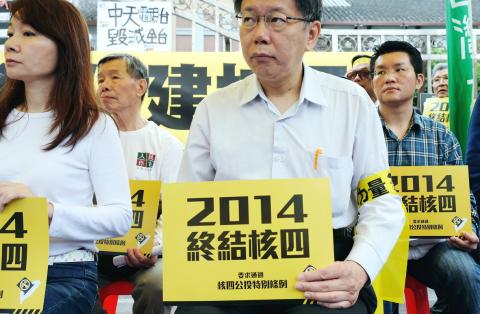Taiwan Power Co (Taipower, 台電) yesterday said the public should consider the possibility of electricity rates being hiked if the Fourth Nuclear Power Plant does not go online.
The comment came in response to former Democratic Progressive Party (DPP) chairman Lin Yi-xiong (林義雄) beginning a hunger strike in Taipei yesterday to protest against the completion of the plant in New Taipei City’s Gongliao District (貢寮) and to encourage the government to recognize that the public is opposed to the plant.
Lin, 72, began his hunger strike at the Gikong Presbyterian Church (義光教會) on Xinyi Road.

Photo: Sam Yeh, AFP
“We respect Mr Lin’s dedication to pushing the government to implement a specific energy policy [to halt construction of the plant], and that is all I can say,” Taipower vice president Roger Lee (李鴻洲) told reporters on the sidelines of a corporate event.
As the supervisor of the plant’s construction, Taipower welcomes the public to express their support or dissent for the Fourth Nuclear Power Plant and nuclear energy, Lee said.
However, one should consider whether there is need to complete construction of the plant from more than one perspective, and people may be required to pay more for non-nuclear plant generated electricity, Lee said.
Taipower plans to finish its security test at the controversial plant by the end of June, as scheduled by the Ministry of Economic Affairs, and will let the government decide whether to install the fuel rods in accordance with its energy policies afterward, he said.
Wu Yu-jen (吳玉珍), a spokesperson for the ministry’s task force on the plant, said Taiwan would face power shortages if the Fourth Nuclear Power Plant does not become operational, since the three operating plants — Jinshan Nuclear Power Plant in Shihmen District (石門) and Guosheng Nuclear Power Plant in Wanli District (萬里) of New Taipei City and Ma-anshan Nuclear Power Plant in Ma-anshan (馬鞍山), Pingtung County — are scheduled to be retired by 2025.
Despite the generation of electricity from alternative energy sources, electricity shortages would remain an issue and would have a considerable impact on households as well as businesses, she said by telephone.
“The shortage issue would only get worse, especially in northern Taiwan,” Wu said.
Taipei uses up to 40 percent of the total electricity generated annually by Taipower nationwide because of its large population.
Taipei residents might face power restrictions sooner than expected, as the Linkou coal-fired power plant in New Taipei City and the Hsieh-ho coal-fired power plant in Keelung are scheduled to be shut down this year.
If the three operating nuclear power plants retired as scheduled in 2025, the country’s total electricity supplies would drop by 40 billion kilowatts a year, if Fourth Nuclear Power Plant was not completed, which would leave up to 90 percent of household demand for electricity unmet, Wu said.

CHIP RACE: Three years of overbroad export controls drove foreign competitors to pursue their own AI chips, and ‘cost US taxpayers billions of dollars,’ Nvidia said China has figured out the US strategy for allowing it to buy Nvidia Corp’s H200s and is rejecting the artificial intelligence (AI) chip in favor of domestically developed semiconductors, White House AI adviser David Sacks said, citing news reports. US President Donald Trump on Monday said that he would allow shipments of Nvidia’s H200 chips to China, part of an administration effort backed by Sacks to challenge Chinese tech champions such as Huawei Technologies Co (華為) by bringing US competition to their home market. On Friday, Sacks signaled that he was uncertain about whether that approach would work. “They’re rejecting our chips,” Sacks

Taiwan’s long-term economic competitiveness will hinge not only on national champions like Taiwan Semiconductor Manufacturing Co. (TSMC, 台積電) but also on the widespread adoption of artificial intelligence (AI) and other emerging technologies, a US-based scholar has said. At a lecture in Taipei on Tuesday, Jeffrey Ding, assistant professor of political science at the George Washington University and author of "Technology and the Rise of Great Powers," argued that historical experience shows that general-purpose technologies (GPTs) — such as electricity, computers and now AI — shape long-term economic advantages through their diffusion across the broader economy. "What really matters is not who pioneers

In a high-security Shenzhen laboratory, Chinese scientists have built what Washington has spent years trying to prevent: a prototype of a machine capable of producing the cutting-edge semiconductor chips that power artificial intelligence (AI), smartphones and weapons central to Western military dominance, Reuters has learned. Completed early this year and undergoing testing, the prototype fills nearly an entire factory floor. It was built by a team of former engineers from Dutch semiconductor giant ASML who reverse-engineered the company’s extreme ultraviolet lithography (EUV) machines, according to two people with knowledge of the project. EUV machines sit at the heart of a technological Cold

TAIWAN VALUE CHAIN: Foxtron is to fully own Luxgen following the transaction and it plans to launch a new electric model, the Foxtron Bria, in Taiwan next year Yulon Motor Co (裕隆汽車) yesterday said that its board of directors approved the disposal of its electric vehicle (EV) unit, Luxgen Motor Co (納智捷汽車), to Foxtron Vehicle Technologies Co (鴻華先進) for NT$787.6 million (US$24.98 million). Foxtron, a half-half joint venture between Yulon affiliate Hua-Chuang Automobile Information Technical Center Co (華創車電) and Hon Hai Precision Industry Co (鴻海精密), expects to wrap up the deal in the first quarter of next year. Foxtron would fully own Luxgen following the transaction, including five car distributing companies, outlets and all employees. The deal is subject to the approval of the Fair Trade Commission, Foxtron said. “Foxtron will be